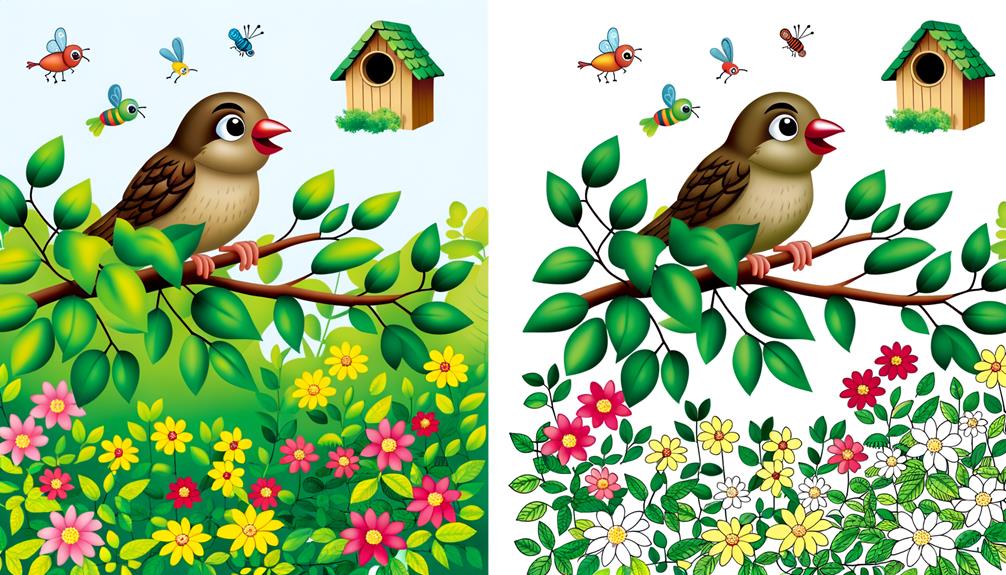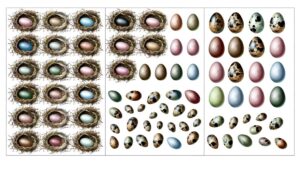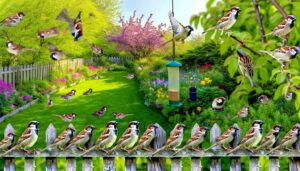7 Fun Facts About House Sparrows for Children
The House Sparrow is a compact bird, approximately 16 cm long, exhibiting sexual dimorphism. Males have distinct grey, black, and chestnut markings, while females and juveniles are camouflaged in brown and grey.
Adaptable to various habitats, they thrive from cities to farmlands worldwide. Their omnivorous diet includes seeds, insects, and human leftovers.
House Sparrows are highly social, forming flocks to enhance safety and foraging efficiency. Their nests, meticulously constructed from diverse materials, shelter eggs and young with both parents sharing nurturing duties.
Exploring these behaviors further uncovers the intricate details of their lives and ecological impact.

Key Takeaways
- House Sparrows are small birds, about 16 centimeters long, and males and females have different colors.
- These birds can live in cities, parks, farms, and sometimes even forests.
- They eat seeds, grains, insects, and leftovers from humans.
- House Sparrows live in groups to stay safe and find food together.
- They build nests from grass and feathers, and both parents care for the eggs.
Physical Characteristics
The House Sparrow (Passer domesticus) exhibits a compact body structure, measuring approximately 16 centimeters in length, with sexual dimorphism evident in the distinct coloration patterns between males and females.
Males typically possess a grey crown, black bib, and chestnut nape, while females and juveniles display more subdued brown and grey tones, aiding in camouflage.
The robust beak, adapted for seed consumption, varies from black in breeding males to yellowish-brown in females and non-breeding males. Their wings are short and rounded, facilitating agile flight.
The plumage includes streaked brown and black back feathers, enhancing their ability to blend into urban and rural environments. These morphological traits contribute to the House Sparrow's adaptability and survival in diverse settings.
Habitat and Range
Widely distributed across multiple continents, House Sparrows thrive in diverse habitats ranging from urban environments to agricultural landscapes, demonstrating remarkable ecological flexibility. These adaptable birds are frequently found in close association with human settlements, benefiting from the abundance of food and nesting sites. Their presence is noticeably prevalent in cities, towns, and rural areas, where they can exploit a variety of ecological niches.
Key habitats include:
- Urban Areas: Found in parks, gardens, and buildings.
- Agricultural Landscapes: Nest in barns, silos, and other farm structures.
- Natural Settings: Occasionally inhabit forests and grasslands, though less common.
This adaptability has enabled the House Sparrow to become one of the most widespread bird species globally, impacting local ecosystems significantly.
Diet and Feeding
House Sparrows exhibit an omnivorous feeding behavior, consuming a diverse array of food items ranging from seeds and grains to insects and human food scraps. Their diet primarily consists of seeds from grasses and weeds, which provide essential nutrients.
These small birds also consume insects, particularly during the breeding season, to meet the higher protein demands of growing chicks. Additionally, House Sparrows are known to forage on discarded human food, such as bread crumbs and food remnants. This adaptability in diet allows them to thrive in urban environments where natural food sources may be limited.
Seasonal variations also influence their feeding habits, with a noted increase in insect consumption during warmer months when insects are more abundant.
Social Behavior
In addition to their adaptable feeding habits, House Sparrows exhibit complex social behaviors that include forming flocks, engaging in communal roosting, and participating in intricate communication systems. These behaviors are essential for their survival and social structure.
House Sparrows often form large flocks, which provide several advantages:
- Predator Detection: Increased vigilance against predators.
- Foraging Efficiency: Enhanced ability to locate food sources.
- Social Learning: Opportunities for young sparrows to learn from experienced members.
Communal roosting is another key behavior, where multiple birds gather in a single location to sleep, thereby conserving heat and providing safety in numbers.
Their communication system involves a variety of vocalizations and body language, enabling effective coordination and social interaction within the flock.
Nesting and Reproduction
Throughout the breeding season, House Sparrows exhibit a highly structured nesting behavior characterized by the selection of sheltered sites and the construction of intricate nests using a variety of materials.
They often choose locations such as building eaves, tree cavities, and birdhouses, ensuring protection from predators and environmental elements.
Nests are meticulously crafted from grass, feathers, paper, and string, providing a soft, insulated environment for egg incubation.
Females lay between 3 to 7 eggs per clutch, with both parents sharing incubation duties.
The incubation period lasts approximately 11-14 days, followed by a fledging period where chicks remain in the nest for an additional 14-17 days.
This cooperative approach enhances the survival rates of the offspring, ensuring species continuity.
Conclusion
Despite being one of the most common and extensively studied bird species, the house sparrow remains an intriguing subject for ornithological research. Its adaptive physical characteristics, diverse habitats, and complex social behaviors illustrate a remarkable evolutionary success story.
Ironically, while its ubiquitous presence might render it seemingly mundane, the house sparrow's intricate life cycle and ecological significance invite a deeper appreciation. Therefore, even the most ordinary of creatures can offer profound insights into the natural world.






